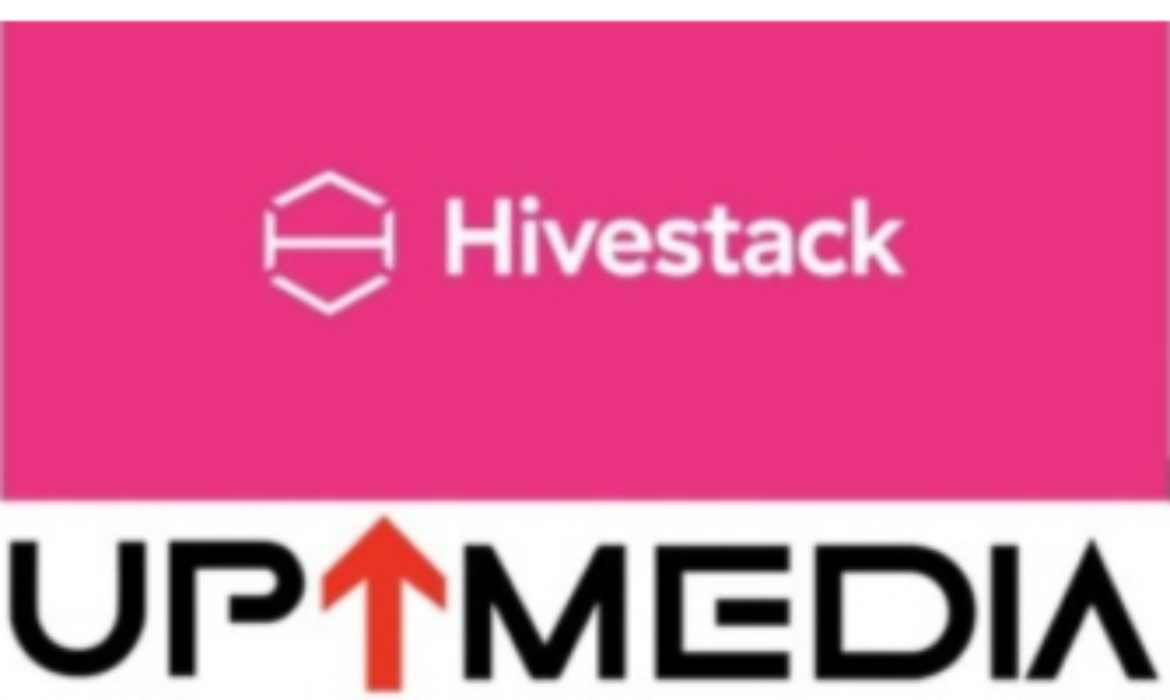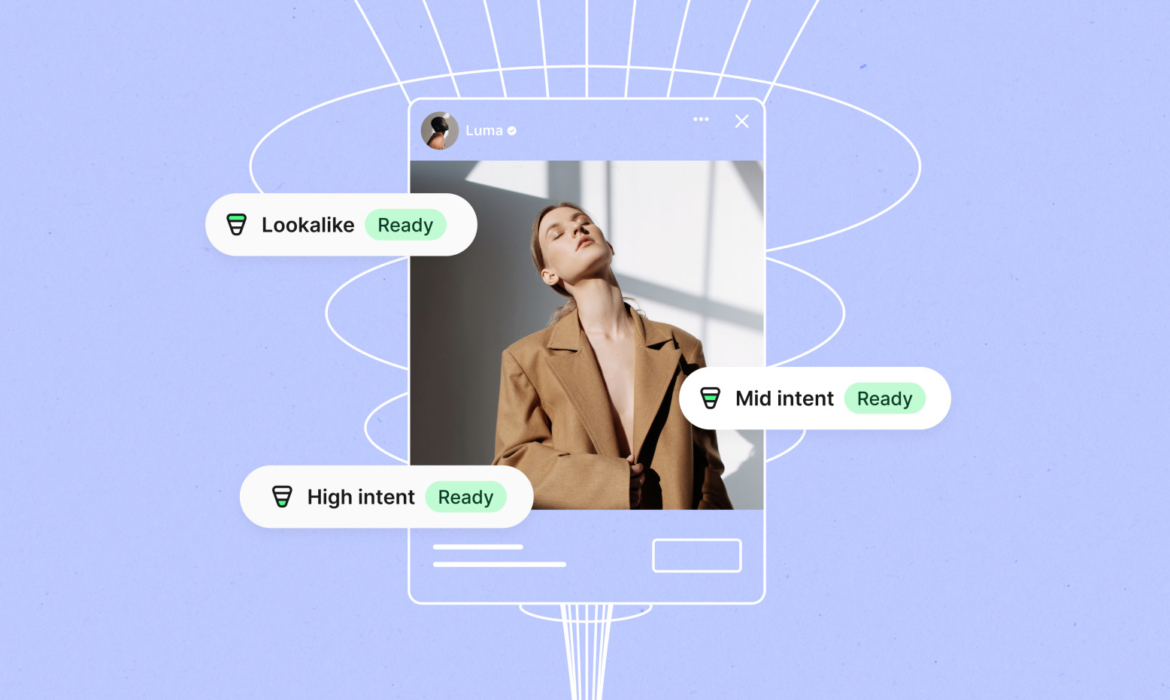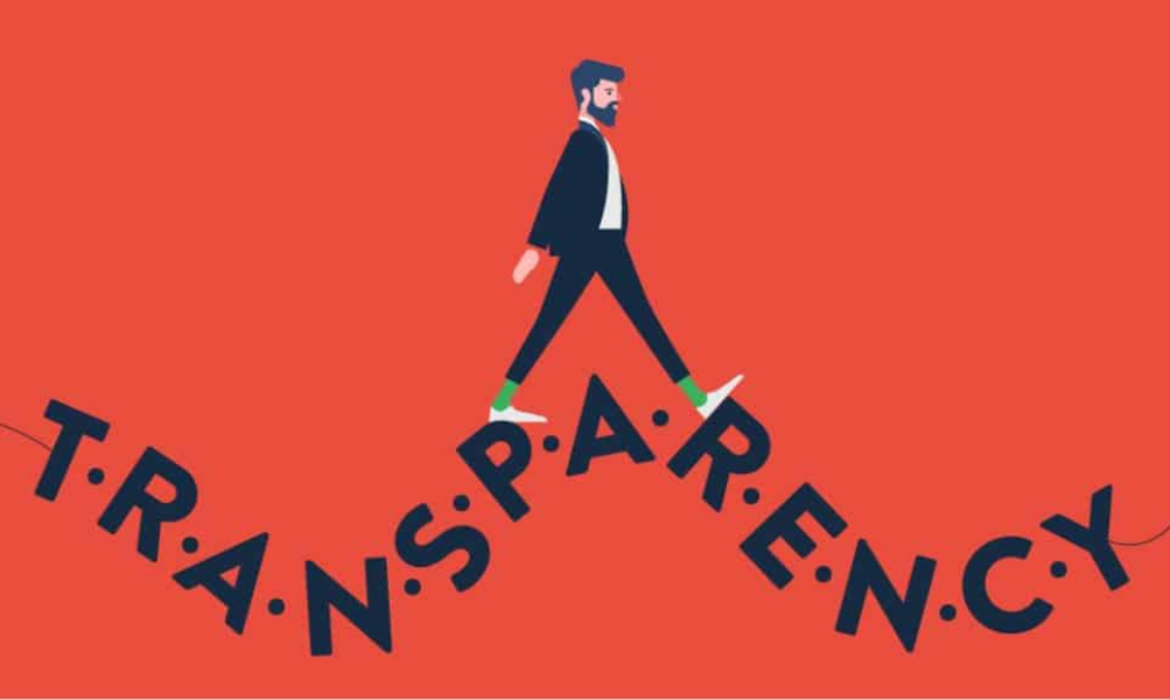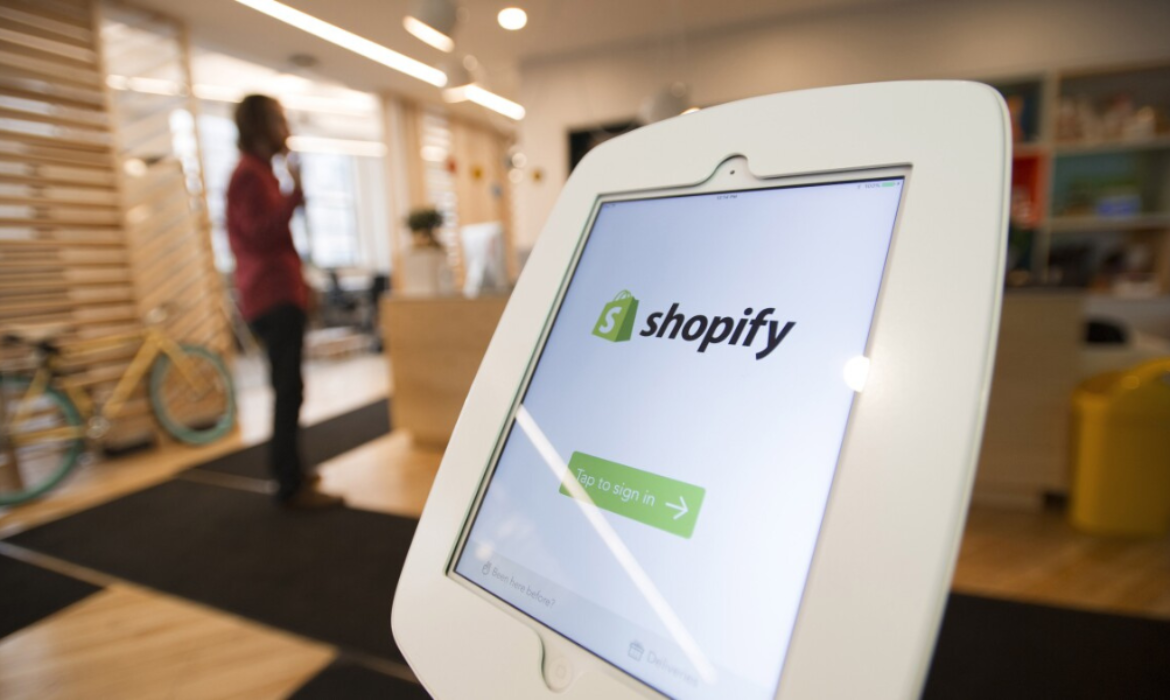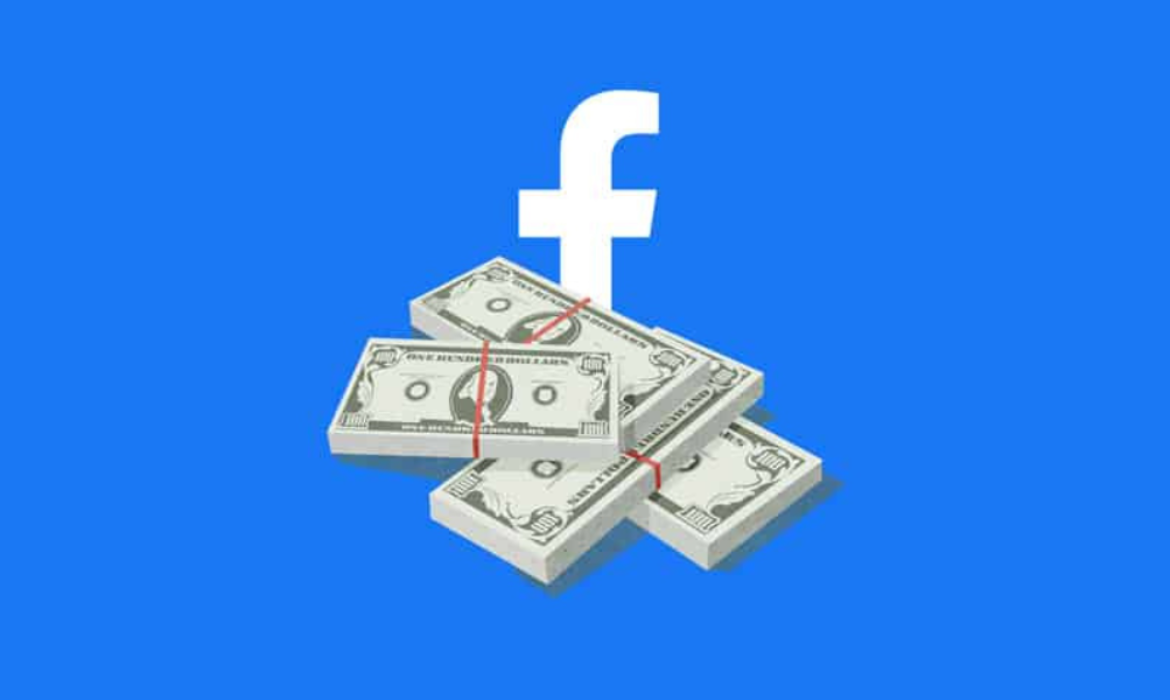Programmatic or Problematic? The Battle Against Made-for-Advertising Websites
The persistent issue of Made-for-Advertising (MFA) websites continues to cast a shadow over the digital advertising industry. These platforms, primarily designed to absorb advertising dollars, have prompted substantial concern and led to a multi-billion dollar spending spree by advertisers.
A recent industry report exposed the magnitude of this predicament, revealing that advertisers collectively poured billions into MFA websites. In response, ad-tech vendors have embarked on a mission to rectify the situation over the past few months. However, the question looms – is their concerted effort making a tangible impact?
The Made-for-Advertising Websites Saga
The saga of MFA websites is not a recent revelation; it has been a thorn in the side of digital advertising for quite some time. CNBC even created a fake website that plagiarized content, underscoring the lack of quality controls for advertisers and ad-tech partners.
This year, the Association of National Advertisers unveiled a damning two-part report. It exposed that approximately 15% of programmatic, open-web advertising dollars funneled into MFA websites, accumulating a staggering $10 billion in ad spend.
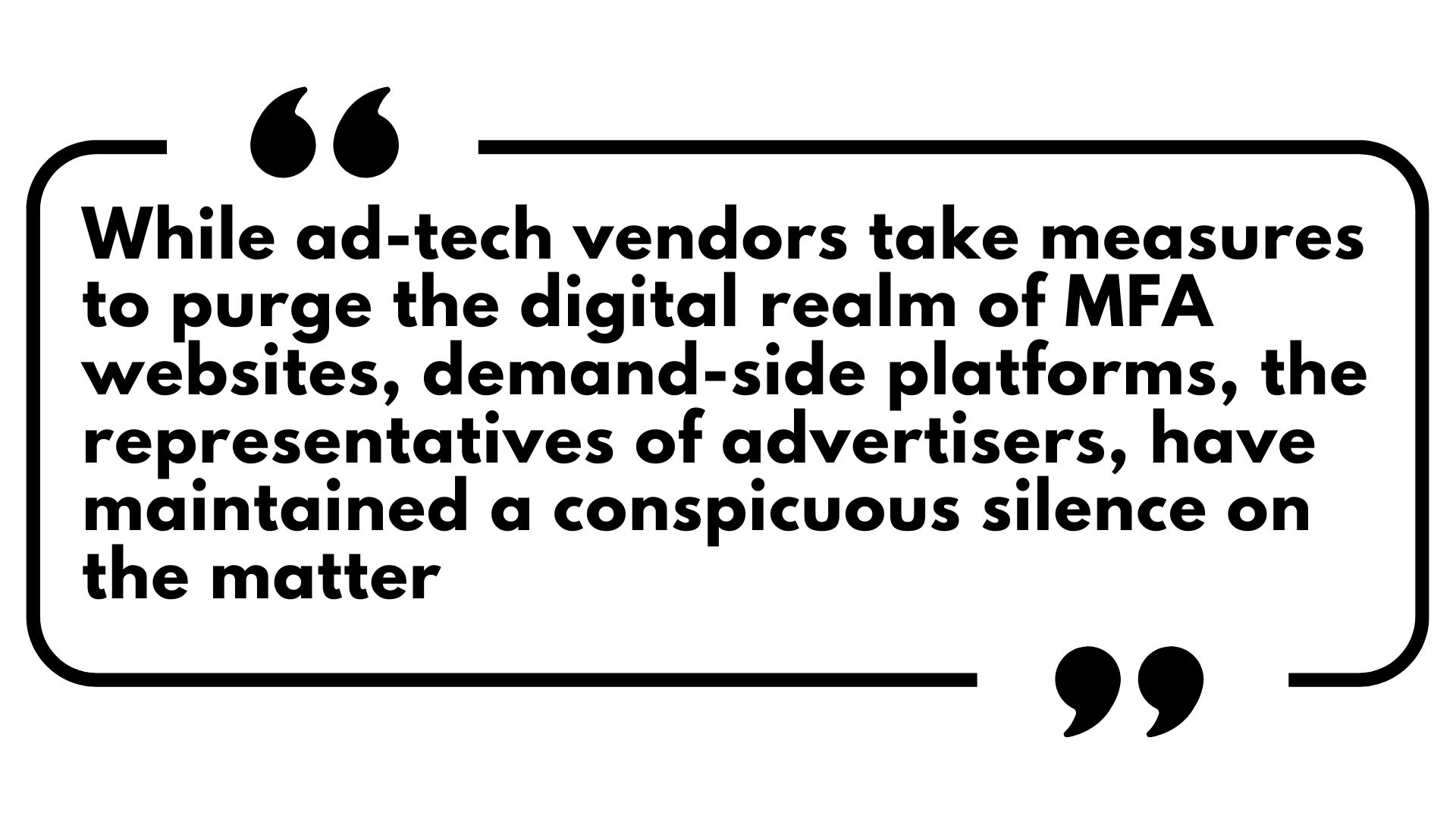
In response to the report’s first installment in June, major ad-tech vendors, including Pubmatic, Magnite, and OpenX, pledged to exclude MFA inventory from curated publisher lists sold to select advertisers. However, advertisers navigating the open web still face the challenge of sifting through MFA inventory.
Notably, both DoubleVerify and Integral AdScience, two industry giants specializing in verification and brand safety, introduced distinct detection tools. These tools aim to shield advertisers from the clutches of MFA inventory, representing a significant step in fortifying the digital advertising ecosystem.
While ad-tech vendors take measures to purge the digital realm of MFA websites, demand-side platforms, the representatives of advertisers, have maintained a conspicuous silence on the matter. This silence prompts contemplation about their stance and the role they play in mitigating the MFA challenge.
Important steps for advertisers
Here are five essential steps for advertisers to elevate their approach and drive efficiency gains:
- Active Stewardship: Advertisers must take the reins and actively steward their media investments. It’s time to move away from complete delegation to agencies and embrace a more hands-on role in ensuring the efficacy of every advertising dollar spent.
- Data Access Contracts: Establishing direct data access contracts with primary supply chain partners is crucial. Transparency and data access rights are inseparable. Advertisers should consider direct contracts with DSPs, SSPs, and Ad Verification vendors to maximize transparency and control over data.
- Agency Partnerships with Full Transparency: Construct agency partnerships that provide complete access to data and full transparency of websites purchased on media buys. Understanding the distinction between the agency acting as an agent or principal is vital. Advertisers need clarity on when agencies are obligated to act in their best interests and ensure contractual transparency.
- Quality Over Quantity: Prioritize quality media buys over chasing low-cost inventory. Cheap CPM buys may lead to non-viewable and non-measurable media purchases. Striking a balance between cost-effectiveness and ad quality—ensuring viewability, fraud-free interactions, and brand safety—is essential for sustainable advertising efforts.
- Exclusion of “Made for Advertising” Websites: Demand the exclusion of “Made for Advertising” (MFA) websites from media buys unless explicitly wanted or needed. Advertisers should assess if MFA sites align with their brand suitability standards for content and user experience. Clearly defining the tolerance for the inclusion of MFA inventory in campaigns is essential.
As the industry grapples with this pervasive issue, the battle against MFA websites unfolds, and the efficacy of these countermeasures remains to be seen. The shadows cast by MFA websites persist, challenging the industry to innovate and fortify its defenses in the ever-evolving digital marketing landscape.
This article is written by Priyanshu Pande, Business Consultant
Priyanshu Pande
Business Consultant | Storytelling | Sports Marketing | Brand Marketing
Priyanshu is a passionate storyteller who has a penchant for building brands and a knack for understanding spreadsheets. With over 16 years in brand & sports marketing, he has worked on all facets of sports business in India – from formulating sports marketin strategies and activating brands to leverage sponsorships to managing atheletes & marketing sports teams & bodies.
Priyanshu’s driving force at work is the obsession to bring brands to life & closer to consumers with the power of design, right messaging & apt medium.
The Ad-Tech Transition: A Comprehensive Comparison and Emerging Players Post-Sizmek
Introduction:
As the ad technology landscape continues to change dramatically, especially with the impending shutdown of Sizmek ad servers in Q4 2024, advertisers are actively looking for robust alternative ways to ensure that their ad campaigns will be served well and get reports for every touchpoint. Although Amazon has officially named integrated partners to facilitate the transition via Smartly and Flashtalking, there is another notable contender that emerged from the crowd: Pro.V9 Ad Studio by Animmoov Media.
The Amazon-Sizmek Exchange:
Amazon acquired Sizmek in 2019 for more than $30 million, but the challenges that were posed by Yacor and the subsequent decision to shut down Sizmek’s ad servers left advertisers looking for new ad options, according to the report presented. The other two platforms that Amazon is pushing are Flashtalking and Smartly. These platforms acknowledge that they have a very flexible integration process, and Amazon has stood by their commitment to simplify the transition for brands.
Flashtalking and Smartly: “Alternatives in Advance of the Shutdown of Sizmek by Amazon”
Flashtalking and Smartly position themselves as traditional ad servers, providing automated features for creative versioning and distribution. Recognized as Amazon’s alternative post-Sizmek, Flashtalking’s familiarity and functional similarities to Sizmek make it a compelling choice for advertisers.
There are many advertisers who would like the option of Flashtalking, which saves them huge ad serving and setup costs, especially mid-tier and small/independent advertisers who do not need the advanced-level functionality of DCO.
Smartly, however, is an unconventional partner. It’s not really an ad server; rather, it’s a dynamic creative shop designed specifically for Google and social media and built on the Google ad platform.
There are a few growing industry firms covering the advertiser demand gap in quick creative automation and Ad serving.
Introducing Pro.V9 Ad Platform by Animmoov Media: A Closer Look at the Revolutionary Solution in the Ever-Evolving Ad-Tech Landscape
Amidst the considerations, the Pro.V9 Ad Platform has gained attention as a robust alternative. Pro.V9 Platform boasts a top-tier server and serves as a state-of-the-art ad production studio. Its flexibility across platforms, rapid turnaround time, and cost-effectiveness make it an appealing choice for businesses.
With a strong emphasis on quality and efficiency, Animmoov’s Pro.V9 platform has positioned itself as a leading provider in the ever-evolving digital landscape. By expanding your advertising tool kit with the Pro.V9 platform, you gain a robust set of features and capabilities from interactive videos to immersive experiences.
Exploring the Distinctions in Ad-Tech Solutions
1. Advertising Studio:
Animmoov’s Pro.V9 offers a powerful hybrid ad-design studio that allows you to show your creative capabilities using unlimited interactive rich media formats from scratch or pre-defined templates.
Pro.V9 excels in communication, interactivity, and responsiveness, distinguishing itself from other platforms more focused on DCO, social media, and Google creatives.
2. White-labelled self-serve and managed service:
Pro.V9 provides a comprehensive range of options to empower you as the owner of the creative process. From creating captivating advertisements to effortlessly serving and exporting them, this platform offers a self-serve facility that puts you in full control.
Consider tapping into Animmoov’s dedicated team for a smooth extension of your own, or opt for customization using their white-label solution to finely tune your advertising strategy effortlessly.
3. Support, turnaround time, and cost:
Pro.V9 excels in providing the fastest turnaround times and cost-effective solutions, making them stand out in the industry. Their ability to deliver high-quality campaigns promptly sets them apart from other players. In addition, Animmoov offers exceptional support and assistance for both self-serve and managed services.
4. Flexibility and Creativity:
Pro.V9 Platform’s notable distinction lies in its flexibility compared to industry counterparts offering advertisers to choose interfaces and ad formats that are specifically tailored to different platforms, which ultimately enhances the accuracy and creativity of their campaigns.
5. Comprehensive Solution:
Pro.V9’s entire approach extends beyond simply displaying advertising and provides a wide range of creative solutions tailored to all platforms. Furthermore, it offers powerful data analytics, planning tools, and a large ad network, collaborating with various large agencies, companies, and networks on a global basis.
As advertisers find themselves navigating the closure of Sizmek, they are presented with the opportunity to explore alternative platforms. Animmoov’s Pro.V9 is one such solution that offers advertisers a compelling alternative to Sizmek with a robust ad studio and serving platform. Its ability to deliver quick turnaround times and provide cost-effective solutions further solidifies its position in the market. In weighing the decision to switch from Sizmek to another platform, advertisers can make an informed decision by evaluating all the provided information that aligns with their specific needs and goals.
Read More: AdTechStats 2023 By ADScholars: Understanding the Ad Trends To Strategize Advertising in 2024.
Equativ Incorporates NinaData for Enhanced Contextual Targeting
Equativ, the top independent ad tech platform, has integrated with NinaData, a Finnish buying intent platform. Equativ’s Buyer Connect (EBC) digital ad curation platform now offers access to NinaData’s sophisticated contextual targeting and buying intent features. Additionally, it will make it possible for media buyers to successfully target the intended audience segments with appropriate ads at scale. Additionally, it won’t make use of first-party data or cookies.
NinaData’s Buying Intent platform
NinaData has unveiled the world’s best predictive buying intent tool for digital and programmatic advertisers. It makes use of the most recent generative AI technology to propel brands’ in-the-moment web outcomes. With NinaData’s LLM, purchase intent predictions will be delivered in place of text or picture solutions utilizing ChatGPT, and marketers will be shown precisely where these audiences may be reached.
NinaData – Equativ Integration
The Buyer Connect platform from Equativ gives buyers a number of tools, such as real-time media planning, to manage their private marketplace transactions effectively. Advertisers looking for privacy-focused addressability solutions will have additional access thanks to the integration with NinaData’s generative AI-powered purchase intent capabilities. In a setting that prioritizes privacy above all else, this will assist marketers in reaching consumers at the precise moment they are making a purchasing decision.
Read More: ThinkAnalytics’ Contextual Advertising Solution Joins AWS Clean Rooms
Here’s what they said
Valtteri Pukander, CEO of NinaData said,
We’re thrilled to partner with Equativ and bring our contextual LLM targeting capabilities to the company’s platform – by leveraging our buying intent targeting alongside Equativ’s Buyer Connect platform, advertisers can automate and streamline the ad buying process at scale, saving time and resources. Equativ is highlighting its commitment to privacy-first solutions by integrating our contextual advertising platform that doesn’t require any first-party data or user consent to provide buying intent insights.
Matthew O’Reilly, senior director, of platform partnerships at Equativ commented,
By bringing together a portfolio of partners that offer industry-leading data solutions, such as NinaData, our Equativ Buyer Connect offers media buyers seamless access to a multitude of targeting options designed to meet the needs of today’s privacy-centric marketers. Together, we are delivering high-performing contextual ads that drive results for advertisers and publishers while protecting consumer privacy.
About NinaData
With its main office located in Helsinki, Finland, NinaData is the first industry-leading Generative AI system that enables meaningful and private interactions between programmatic advertising operators and advertisers. The technical expertise of the NinaData technology team is combined with a wealth of industry experience and a lengthy history of developing scalable, high-value, and high-performance architectures for AI analytics of media content. The management and data scientists of NinaData blend methodological expertise with real-world application knowledge. They have previously held positions as co-founders of prosperous businesses, AI engineers, AI business managers, and researchers in machine learning.
Read More: Equativ Partners with Utiq for Ethical Programmatic Marketing Practices
Hivestack partners with Up Media to Expand Thai DOOH Market Share
The world’s top independent programmatic digital out-of-home (DOOH) ad tech business, Hivestack, has increased its market share in Thailand. In order to achieve this, Up Media, a renowned media owner who specializes in elevator screens, recently developed a DOOH relationship with the company. As a result of this partnership, 2,000 Up Media DOOH screens on elevators will connect to Hivestack’s Supply Side Platform (SSP). These displays can be found in upscale shopping centers, business buildings, hotels, and dwellings. Furthermore, buyers in Southeast Asia will have access to it immediately. Additionally, the Private Marketplace (PMP) and Open Exchange agreements will make it accessible to everyone worldwide.
Thailand Projected Ad Spend
The anticipated DOOH ad spend in Thailand alone is expected to reach USD 213.20M in 2023 with a 6.01% annual CAGR. Furthermore, the projected market is also expected to reach USD 269.30M by 2027.
Hivestack Expands DOOH Marketplace
The Hivestack platform had produced 14.4B monthly impressions over an amazing network of DOOH inventory in Thailand before the arrival of Up Media. They included billboards, metro systems, commercial centers, and train stations found in Phuket, Bangkok, Chiang Rai, and Chiang Mai. With the addition of Up Media’s most recent elevator screens, Hivestack is now able to offer DOOH purchasers in Thailand a degree of audience interaction that is unheard of. Additionally, it opens up a new source of income for Up Media from global outside-in purchases.
Read More: Vistar Media Enhances DOOH Advertising with Retail Inventory Package
Hivestack in Thailand
In March 2022, Hivestack began operations in Thailand. Since then, it has significantly expanded its market share by working with the main media owners in the nation. It has also worked to promote several brands through interesting programmatic DOOH campaigns. The top food and beverage company in the nation, Bar.B.Q. Plaza, turned to Hivestack in September 2022 to promote brand awareness, produce creative campaigns, and boost foot traffic to its outlets. The end product was a fascinating, interactive programmatic DOOH activity that reached over 4 million people at 16 BTS key train station sites.
Here’s what they said
Joey Zhou, Founder & CEO, of Up Media said,
We are excited to collaborate with Hivestack and we are going to scale up our inventory – aiming to triple it in the next 12 months. Exciting times ahead as we are offering advertisers impactful media for high end audiences in the best locations across Thailand.
Jan Harling, CEO, of Virtus Asia Consulting (local consultancy for Up Media) added,
I am confident that many marketers with a focus on premium audiences will view the availability of this inventory, now accessible programmatically, as a game-changer in Thailand. This opportunity aligns perfectly with Thailand’s recovery, marked by bustling shopping malls and offices returning to their full-capacity state. It promises a significant shift in the landscape of impactful media opportunities.
Matt Bushby, Managing Director ANZSEA, Hivestack commented,
It’s been an incredible journey for us in Thailand with the amount of growth we’ve achieved with our partners. We’re so proud to be building the largest DOOH inventory network and are proud of the large number of successful brand campaigns we have under our belt already in the region. Our partnership with Up Media comes at an exciting time for our business as we onboard more screens in different formats across Thailand, located in Bangkok, Chiang Mai, Chiang Rai, and Phuket.
Read More: Moving Walls Teams Up with Place Exchange for Global DOOH Inventory
Shopify Audiences Expands Ad Targeting Capabilities with New Integrations
Shopify Audiences, Shopify’s ad tech integration offering revealed a new ad targeting capability. Additionally, it increased the number of its partners. Initially, Shopify Audiences debuted with just Google and Meta. Later on, Pinterest was included in the mix. Recently, Shopify Audiences announced new connections with three significant ad platforms, Snap, TikTok, and Criteo. The collaborations increase the effectiveness and reach of Shopify Plus merchants, enabling them to more precisely target customers. The platforms will be able to connect to Shopify utilizing their preferred ad network for modeling data.
Shopify audiences
Shopify Audiences was introduced last year with the goal of streamlining client acquisition and assisting retailers in raising their return on ad spend (ROAS). It now offers greater analytics and links to new ad channel partners, including Snap, Criteo, and TikTok, thanks to an updated version. It also has the best algorithms yet, which can cut customer acquisition costs by as much as 50%. The strong ad platform alliances enable Shopify Plus retailers to contact their target clients more extensively and affordably.
Benchmarking functionality for optimized ad performance measurement
With the help of Shopify Audiences’ benchmarking feature, retailers can assess how well their advertising campaigns are performing against those of other companies in a similar industry. The function also offers additional insights and makes it easier to make data-driven decisions. It enables businesses to improve the effectiveness of their advertising. The updated features add to a tool that is always being improved to increase consumer acquisition and return on advertising spend. For instance,
T-shirts created to order are available from a vendor. Despite the fact that they sell clothing, they are not high-end outfit designers. With Shopify Audiences’ new benchmarking feature, they can assess the success of their campaigns against those of other, comparable businesses, not only clothing stores. With a more apples-to-apples comparison, this offers more insightful information.
Read More: Roku-Shopify Revolutionize TV Ads By Enabling On-Screen Purchases
The Shopportunity
Shopify Audiences does not collect or offer user-level data. It can create unique audiences who could be interested in a certain product. This is thanks to Shopify’s data modeling hub, which is based on Shopify’s analysis of its merchant base. In comparison to other payment-based advertising products, Shopify Audiences offers less privacy exposure. Shopify is now at ease adding third-party programmatic thanks to Criteo.
The algorithm becomes more effective as more companies use Shopify Audiences and sign up for the platform, using particular insights from customers across participating shops. This in turn boosts output, creating a positive feedback loop. The success of Shopify Audiences is heavily dependent on this loop. Additionally, it’s stated that Shopify Audiences is a major factor in why merchants decide to upgrade to Plus, with many implementing it an average of one week after their upgrade.
Shopify Purpose
The Shopify Plus package, a more expensive membership level for their e-commerce platform, includes Shopify Audiences. Shopify doesn’t receive any CPM revenue. Furthermore, unlike retail media networks, it doesn’t receive a cut of revenues or a high CPM associated with such purchases. This implies that Audiences aren’t always a significant revenue generator. Instead, as it includes new merchants in the Plus category, it gains value. Increased sales from all merchants benefit Shopify, which receives a fee for processing payments. Shopify could easily enter the media category and tie its data to CPM if it wanted to increase its audience revenue. It is the only platform that Meta would consider using to replicate its sales attribution network for e-commerce sellers.
Read More: Criteo’s Commerce Max DSP Unites Retail Media with General Availability
Shopify Momentum
The products from Shopify work together to develop better services for retailers and give them a unified offering. Shopify Plus retailers can use their Shopify Credit cards to pay for their advertising costs while receiving cash back. The audience is a special advantage that only Shopify offers. It uses the combined strength of Shopify merchants to make it easier for them to efficiently attract new clients. Shopify makes investments in this area to help companies reach clients worldwide. Retailers could be reluctant to provide information that will be gathered and then used by other merchants, including potential rivals. They may view their involvement with Shopify Audiences as a means to connect with fresh potential clients.
Here’s what they said
Shopify’s VP of Advertising, David Wurtz said,
Shopify is at the forefront of commerce. Wherever there’s an opportunity to connect merchants and buyers, Shopify is there first. Since launching Shopify Audiences last year, our algorithms have only gotten smarter and more effective thanks to the collective power of our merchants. We’ve long said that commerce is not a zero-sum game. Together, the independent merchants on Shopify help each other win. A lot of the inventory on the open web is underappreciated and underpriced. With the addition of Criteo, Shopify can drive “a lot of volume” of ads to the web and improve customer acquisition costs for its merchants, just like the big social platforms have for particular brands or categories.
Rory Mitchell, Criteo’s GM of global growth added,
Aside from access to Shopify custom audiences, Criteo “can then show the power of our platform, which allows a Shopify merchant to think about things like onboarding their first-party data to our platform for retention or retargeting campaigns. It’s a “natural progression,” he added, from the modeled approach to Criteo’s shopper graph products, which do use onboarded first-party data. And we know how to get performance for these customers in a way that is really scalable across the open internet.
Ali Rana, Global Head of Revenue Partnerships for Snap commented,
We’re thrilled to team up with a commerce leader like Shopify to enable merchants to reach more high-intent shoppers on Snap.
Read More: New ‘Instacart for Shopify App’ Revolutionizes Merchant Advertising
Morgan Stanley Forecasts Australian Ad Spend To Fall By 9% In 5 Years
In a recent analysis by investment bank Morgan Stanley on Australian advertising, it forecasted that the domestic media share will shrink if it doesn’t innovate quickly. The domestic media ad spend was $10.4 billion in 2019 and will fall at an annual rate of 9% over the next five years. In a note to clients, analysts wrote,
“We think investors perpetually underestimate the global leakage of ad spend from Australia.”
A section of marketers holds a viewpoint that the ad spend with Google and Facebook has started to plateau and revenue is returning to the domestic traditional media. However, the analysts completely disagree with this market viewpoint and highlighted numbers that suggest that there can be an acceleration post-COVID 19.
The Australian advertising market has shown little growth over the years – around 1.9 % a year. Also, the financial statements filed with corporate regulator ASIC reveals that over the last three years, global media/tech players’ revenues in Australia increased by roughly 20%.
The global ad tech players like Google, Facebook, Snap, and Twitter as well as emerging players like TikTok continue to take an increase in share in the Australian consumer’s time especially the younger demographics. They will have a larger share in digital media spend in Australia post-pandemic as well.

Image Credit: Ad news
Morgan Stanley forecasts 2.1 % revenue to fall of global tech players in Australia in the current downturn but not as severe as that of domestic media- radio, outdoor, print, and TV. On the other side, the revenue of the domestic media players will see a drop of steep 22.1%
However, the analysts believe that global players will lift their market share in advertising in Australia. For instance, Google Australia’s gross revenue was $4.8 billion in 2019. Morgan Stanley estimates a 4% decline this year owing to the ad industry slow down but expects to rise 13% year-on-year growth up to 4 years to reach between $7 billion and $8 billion in ad revenue a year in 2024.
Analysts say,
“Eventually, COVID-19 will be over and there will be a cyclical recovery in the Australian economy, and a bounce-back in the advertising cycle. ”
He further added that the market will be disappointed in expecting a rise in domestic media earnings.
“Even post COVID-19, when the overall advertising market stabilizes and starts to improve, we think the magnitude of the recovery will disappoint investors.”
“Our point of difference is our thesis … that if the global tech players continue to grow revenue double digits in Australia, but the total pool of ad revenues is only increasing 2% to 3% p.a., there is necessarily a ‘crowding out’ of ad spend left for domestic media companies to pursue.”
The markets underestimate the risks to ad revenue, profit margins, and ROCE(Return on equity) from a 5-year long term view. The main reason for the global tech giants growing faster than local media is structural changes. ‘Necessity is the mother of invention’ and businesses that continue with traditional media platforms for advertising need to change and rethink their strategy.
The analysts in the report mentioned that
“The consistent industry feedback we receive is the current challenges facing large, small and medium-sized businesses across Australia is prompting leadership and management teams to think harder and deeper about becoming more digital,”
Many SMEs have tried marketing on digital platforms for the first time during COVID 19 as consumer behavior and time spent has changed and accelerated towards digital/online/mobile media. It is expected that the same pivot will exist with the advertising budgets.
Unfortunately, the crowding of traditional media- radio, outdoor, TV, print – is set to be more intense.

Image Credit: Adnews
Morgan Stanley continues to have an underweight rating for ASX media companies like Seven West Media, WPP AUNZ, oOh! media and Southern Cross but Nine Entertainment.
Nine Entertainment (NEC)is an exception due to its various revenue sources like digital subscription, streaming, and digital advertising assets. Analysts believe that some Australian media companies have the potential to reinvent themselves and develop digital businesses and NEC has demonstrated the ability for such a reinvention.
The global players may face a threat if they fail to innovate themselves and will lose their consumer share and ad share.
Advertisers Look For Greater Transparency In Programmatic Ad Buying
Time and again, “Transparency’ has been a cause of concern for advertisers in the programmatic ad buying. This has been a long time pending issue which still remains unresolved as advertisers try to uncover what happens to money spent on programmatic ads.
Ad spend is falling and advertisers are again seeking greater transparency into the ad-buying supply chain. Hidden fees, fraud, viewability, and brand safety are the growing concerns that need immediate attention.
Trade body ISBA studies reveal that nearly half (49%) of ad buys disappear before reaching publishers and 34% of this money is the disclosed fees agencies and ad tech vendors take for trading impressions. However, 15% cannot be attributed to what the report called an ‘unknown delta’ on the supply chain. The amount of money that reaches publishers is lower, as the report did not consider ad fraud and ad viewability.
As reported earlier, a noticeable amount of programmatic dollars doesn’t reach the publishers and it is getting increasingly harder to keep a track of where it goes. The trade body struggled for nine months to gather data from the ad tech vendors to make a report on this and when it received data is was unusable.
PwC collected information for the study was data on 267 million impressions traded between 15 advertisers, eight agencies, five demand-side platforms, six supply-side platforms, and 12 publishers from the Association of Online Publishers from Jan. 1 to 20. March. Of those impressions, only 31 million (12%) were actually analyzed by matching log-level and aggregated data across 290 different supply chains.
PwC reported that it was highly cumbersome and hard to collect data on each impression. Ad tech vendors were conservative in sharing data due non-disclosure agreements and data collected was in different formats making it difficult to trace an advertiser’s money to so many different publishers. The advertisers involved in the study were non-premium 40,525 sites on an average.
Generally, an advertiser or agency decides to buy impressions and pay for them on DSP while publishers use SSP to sell their inventory at advertisers. Data on impressions from these two platforms are matched up and PwC did the same. However, data could not give financial transparency for the advertisers and publishers There were still costs in the ‘unknown delta’ that remains unidentified on the report. For instance, hidden fees can be a combination of additional ad tech vendor fees, post-auction bid shading, trading deals, and other unknown factors.
As quoted Sam Tomlinson, marketing assurance partner at PwC in DigiDay,
“This is more because the programmatic ecosystem is built on legacy processes that are a mess.”
Graeme Adams, head of media at BT Group said,
“We desperately need to see a common set of standards adopted and more openness in this market, so that every penny spent is accounted for. If this happens, we’ll invest more in the channel; if not, we will cut back and reshape our trading approaches.”
To conduct such high and intense study is a big expense. For instance, It costs more than £1 million ($1.2 million) to collect and process the data from different sources in ISBA’s study. A lot of emphasis is given to attain log file data by marketers. If the ISBA report proves anything that the log file data can reveal everything about transparency and nothing at the same time.
Ruben Schreurs, managing partner at digital media consulting firm Digital Decisions responds to log file data and said,
“Using the overly sophisticated approach of trying to match log-file data in real-time is like buying the IBM Watson supercomputer to calculate 1+1.”
He added that advertisers should have a sensible and valuable approach by running a periodic review of their net spend on publishers and match it with publisher data cumulatively. This will help to get the right and required output to make value-driven decisions on how to optimize the value chain and avoid complicating technologies.
Nevertheless, the report findings can help the adtech industry and give the insight to enhance financial and data transparency as regulators on impressions as regulators dominate.
Steve Chester, director of media and advertising at ISBA said,
“If the ad industry can be seen to be demonstrating that we can create a more open and transparent market then it could avoid the necessity of being regulated.”
Shopify Revenue Surges As Pandemic Brings More Business Online
E-commerce platform and payment provider Shopify reported its first-quarter revenue that surpassed analysts’ estimates as more businesses moved online to survive coronavirus pandemic.
The Ottawa-based company Shopify said in a statement that sales grew by 47% to $470 million from the same quarter a year ago. However, analysts expected revenues to come to around $443 million
The key metric of gross merchandise volume which represents all goods sold on the platform 46% to 17.42 billion compared to the previous year. Again, beating analysts expected volume to $16.68 billion.
While sales were booming, the company still posted a net loss of $31.4 million or 27 cents a share. However, on an adjusted basis, the company posted a profit of $22.3 million or 19 cents per share for the first quarter of 2020 compared with an adjusted profit of $7.1 million or six cents per share for the same period last year.
CEO Tobi Lutke said in the quarterly release,
We are working as fast as we can to support our merchants by re-tooling our products to help them adapt to this new reality. Our goal is that, because Shopify exists, more entrepreneurs and small businesses will get through this.
Moving Online
Shopify reported a fall of 71% in gross merchandise volume through its store point-of-sale as stores shut down due to pandemic between March 31 and April 24. Companies also downgraded from Shopify Plus to lower-priced plans.
Also, it throws light on the drop in point-of-sale purchases from the brick and mortar stores questions the sustainability of online switch. It provides store based point-of-sale systems to merchants to operate from a single platform in order to maintain online store and sales.
It is closely observing consumer spending habits online and the ability of brick-and-mortar retail merchants to shift sales online. According to the company statement, Shopify retailers managed to replace 94% of their store volume with online sales.
Retail merchants are adapting quickly to social-distance selling, as 26% of our brick-and-mortar merchants in our English-speaking geographies are now using some form of local in-store/curbside pickup and delivery solution, compared to 2% at the end of February.
Chief technology officer Jean-Michel Lemieux noted the surging demand and had U.S. Black Friday-type of traffic as businesses have used Shopify to stay afloat as nationwide lockdown forces retail store closure across the world.
Impact of COVID-19
This pandemic has strained small and medium-sized businesses and accelerated the shift of buying habits to eCommerce. Shopify introduced many initiatives to support merchants and help entrepreneurs start a business online during the ongoing COVID-19 pandemic, including, offering tools to businesses to open their own digital store online across channels including social media.
An extended 90 day free trial for new sign-ups, gift card capabilities to merchants, and introduction to in-store or curbside pickup and delivery options for greater flexibility in the movement of inventory between different locations.
The company stated that the new stores created on the platform grew 62% between March 13 and April 24 versus the prior six weeks, driven by both first times and established sellers. But is also added,
It is unclear how many in this cohort will sustainably generate sales, which is the primary determinant of merchant longevity on our platform.
What analysts have to say
Few analysts still don’t see Shopify profitable enough in the future to justify the current stock price. They believe the rally is overdone.
Barry Schwartz, chief investment officer at Baskin Wealth in Toronto notes that as they grow, the company will face fierce competition from rival Amazon. He added,
They’re up against some very heavy hitters and I don’t think those guys are going to let Shopify win everything.
Buying it here at that valuation, you’re essentially saying, ‘I don’t care.’
Canaccord Genuity downgraded the stock, with a warning “we’re not entirely convinced” that gross merchandise volume “is as bulletproof as perceived.”
Verizon Media Expands DSP to Offer Premium Native Ad Inventory.
Verizon Media has announced the expansion of its demand-side platform bringing in premium, programmatic, and now its full native marketplace inventory, formats, targeting, and measurement into a single unit.
The DSP gives a unified solution to the advertisers to check on every aspect of their buys across all formats and inventory purchases- from planning, buying, and management to optimization.
Today, people are using more screens and devices than before. Therefore, it becomes challenging for advertisers to provide a personalized and unified experience across the media mix. This level of fragmentation eventually leads to using different tools for different formats and then measuring the success of each of them would be laborious. But now advertisers can have access to omnichannel inventories including mobile, digital out-of-home, CTV, video, and audio along with native advertising from a single dashboard.
According to Iván Markman, the chief business officer at Verizon Media,
The Verizon Media native experience was separate from the programmatic capabilities in our DSP…Now both are one, and this includes a lot more consistency planning and measurement and attribution. Over the last few quarters, we’ve looked at bringing more transparency and insights to our DSP.
The expansion of DSP’s functionality provides exclusive access to native ad inventory from Verizon’s owned and operated properties like Tech Crunch, Yahoo, and Huffington Post. The robust native marketplace format and premium inventory along with the programmatic offering, supported by 1st party data will help advertisers navigate a cookie-less environment.
In an era when media agencies are on hiring freeze if not headcount cutbacks, it was essential for the company to improve the efficiency of the tools. Markman stated, “You can now do more with less.“He further added,
Sometimes you’d have seven different platforms for things like digital out of home and native then display. Many of our clients have unfortunately had to furlough some team members or lay off their workforces. This helps with performance.
Facebook Post Strong Earnings in Q1’20, Exceeds Analysts Projections
Its earnings season and Facebook has some relatively good news on that for the investors. It has impressively beaten Wall Street expectations on revenue and earning per share (EPS). Facebook ad revenue grew by 17% Y-o-Y despite the instability in the digital ad market due to COVID-19.

Image Credit: Facebook
Why does it matter?
Interestingly, Facebook was able to beat top and bottom-line revenue expectations amid the coronavirus crisis showing how its business is strong and growing. However, the company didn’t provide specific revenue guidance for Q2 due to the ongoing uncertainty but offered a snapshot on the revenues of upcoming quarters.
- Meanwhile, Facebook said that the current rise in engagement will continue but the usage will come down once the stay-at-home orders are lifted.
- The digital advertising industry has taken a hard hit due to shelter-at-home orders globally. Facebook said in a statement, “We experienced a significant reduction in the demand for advertising, as well as a related decline in the pricing of our ads, over the last three weeks of the first quarter of 2020.”
Let’s talk numbers
- Earning per share (EPS): $1.71 vs. $1.75 per share forecast by Refinitiv
- Revenue: $17.74 billion vs. $17.41 billion forecast by Refinitiv
- Daily active users (DAUs): 1.73 billion

Image Credit: Facebook
- Monthly active users (MAUs): 2.6 billion
- Family Monthly Active people (MAP): 2.99 billion monthly users across its family of apps. This metric helps to measure Facebook’s total user base across its main app, Instagram, Messenger, and WhatsApp.
- The average revenue per user (ARPU): $6.95
- Other revenue: $297 million which is driven by sales of VR headset ‘Oculus.’
- Cash and cash equivalents: $60.29 billion
What lies ahead?
- Facebook is the third internet company that posted strong Q1 results after Snapchat and Google despite the hindrances in the digital ad market. This shows big internet companies will keep dominating the advertising ecosystem due to the pandemic.
- CCS Insight chief operating officer Martin Garner believes the impact of the virus will lead companies to use digital services from advertising to collaboration.
“………..Although Google and Facebook will take a hit from Covid-19, we expect them to be leading indicators of recovery, as digital advertising and other services show early growth in economies getting back to normal.”




